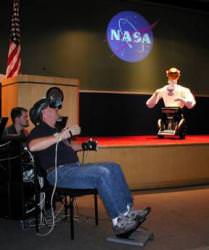When the first humans travel to Mars, the journey will be dangerous. Perhaps the most dangerous part will be the landing; the thin Martian atmosphere makes it extremely difficult to slow down a heavy spacecraft carrying humans. To minimize the danger, the first missions to Mars might not have people land on the surface at all. Instead, they might orbit the Red Planet, and control virtual robots working down below. Just imagine how much science Martian rovers controlled by humans could get done, all from the safety of orbit – at a fraction of the cost of actually setting foot on the planet.
“It is a cheaper, simpler, and safer way to explore, and hence it will be a faster way to explore. Virtual exploration will have the excitement of being there, at a fraction of the price, ” Dr. Landis wrote in a paper titled, Teleoperation from Mars orbit: A proposal for human exploration, published in the May 2007 issue of Acta Astronautica.
A mission to Mars using teleoperation would involve robots landed on the surface which would be controlled directly by astronauts in a spacecraft orbiting the planet. The robots would be more sophisticated than current rovers, with hands and bodies that would mimic the movements of a human being, thus allowing the operator to control the robot using a virtual reality interface. The current lag between the commands from the Earth and their reception by the rovers on Mars can be several minutes, but an orbiter controlling the robots would experience almost no delay at all.
Unlike humans, the Robonauts wouldn’t need a habitat on the surface, and could be left there. They could also be equipped with a large variety of scientific equipment, and wouldn’t need to rest, making the exploration of the surface faster and more efficient.
Sure, it seems a little silly to send humans all the way out to Mars without actually landing them on the surface, but doing so poses many challenges that are eliminated by a teleoperation mission. To design and provide fuel for a vehicle to land on the surface, and then take off, is very expensive both in terms of weight and money.
We still don’t know if there is life on the surface of Mars, so being very careful not to contaminate the surface with Earth microbes is also important. Any missions that land on the surface have the potential of leaving life from our own planet there, making it difficult to later determine the origin of life on Mars – if any exists – and Earth microbes could possibly wipe out any Martian life.
Also, the effect potential life on Mars could have on human beings is unknown, so it is better to be safe than risk the lives of astronauts through exposure to possibly harmful alien life.
Teleoperated missions would expand the areas of Mars that could be explored, since the issue of safety is not as much of concern when using robots.
“Landing sites for a human mission are likely to be scientifically “boring” sites, featuring flat surfaces with an absence of boulders, cliffs, channels, craters or mountains. Use of telerobots lowers risk, and thereby allows dangerous exploration,” Dr. Landis wrote.
Teleoperation wouldn’t be the end, of Mars exploration, though; it’s merely a step towards landing humans on the planet to ensure the safety of astronauts and gain better information on how to conduct future missions.
Source: Acta Astronautica


It is not worth spending billions of dollars in order to send astronauts to conduct a “site tour” of the red planet.
While I am less enthusiastic about Mars than the average space enthusiast (mainly because of a certain lack of resources), traveling millions of miles without a landing would make a great argument for ending the public space program beyond lunar orbit.
Either we go, land and conquer the red planet, or skip it entirely–going their “half way” will not satisfy anyone on either side of the debate, and will doom a second human mission their in the future.
this is kind cool
This is a remarkable stupid idea on so many levels it almost isn’t worth refuting. As Darnell points out, the first problem is that it makes no sense from a political or public relations stand-point. Secondly, it trades the very real risks of exposing astronauts to longer periods of zero-g and cosmic radiation and solar flares (the phrase “the safety of orbit” in this article almost made me choke on my coffee) to avoid the completely imaginary risks of exposing astronauts to Martian microbes. To paraphrase Robert Zubrin, the likelihood of Martian microbes being dangerous to earth life is several orders of magnitude less likely than humans contracting Dutch Elm disease, and anyone who tells you otherwise just doesn’t understand evolution. Then there’s the ridiculous notion that not landing on the surface (or, more correctly, not returning from the surface) will significantly reduce the cost of the mission, when the greatest fuel cost of the mission is expended on the Earth-to-LEO phase. I could go on, but I just hope this idea dies the quick death it so obviously deserves.
If astranauts are to be sent to Mars, they should be landed on its surface. As for Earth’s Microbes being on Mars as a result of people landing, well they could be there due to robots landing.